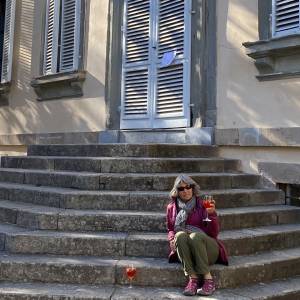Art History, in Vivo
Two artisan families, two historic buildings, two awesome tours. My list of ‘off the beaten path’ things to do in Perugia included visiting a Tessitura Laboratorio (weaving workshop) and a Vetro Laboratorio (stained glass workshop). Having seen exquisite stained glass and woven fabric (actual cloth or in masterpiece paintings) in churches, palaces, and museums throughout Italy, we thought visiting the workshops worthy of a visit to better appreciate the skill and craftwork of the artisans creating such beauty.
Inside a 13th century convent, tucked in a side street near the University of Perugia, Master Weaver Marta and 4 apprentices continue the tradition of weaving intricate Perugian Tablecloths using medieval and Rennaissance techniques & patterns on authentic 18th and 19th century looms. Marta’s great-grandmother, Giuditta Brozzetti, founded the Atelier in 1921. She manifested her dream to revive the lost art of woven Perugian Tablecloths, by collecting looms and weavers (all women) from the Umbrian countryside and recreating a weaving workshop. The techniques and workshop has since passed down from mother to daughter for 4 generations. It was fascinating to learn that Marta’s dyslexia led to the “cracking of the code” of authentic medieval and renaissance patterns from masterpiece paintings. The pattern code had been lost over the centuries, but Marta could “read” and thus replicate the code by studying masterpieces by Leonardo da Vinci, Ghirlandaio, Pintrucchio and other artists. The tablecloth featured in Da Vinci’s last supper, was an actual Perugian Tablecloth, and Marta can now weave an exact replica.
On the other side of Perugia’s historical center, descendants of the Moretti-Caselli family live and work in a 15th century palace maintaining the legacy of stained glass art started by Francesco Moretti in 1858. Five generations of stained glass artists. Francesco Moretti’s great-granddaughter described the chemical process and artistic technique of creating stained glass. The extensive apartment included the original workshop with oven, tools and chemicals; the ‘drawing’ studio with the ‘cartoons’ and models used to design stained glass commissioned works during the last century; gallery of Moretti-Caselli stained glass art; and the current ‘modern’ workhop and oven. A fascinating family tree of artisans.
Featured Blip and first extra from the Tessitura (weaving) laboratorio, the other two extras is a lifesize stained glass portrait of Queen Margherita (yes, the pizza was named in her honor) by Francesco Moretti, and some of the chemicals and materials used to create that masterpiece.
- 0
- 0
- Apple iPhone 14 Pro
- 1/50
- f/2.8
- 9mm
- 250

Comments
Sign in or get an account to comment.


